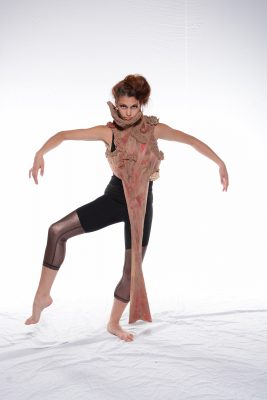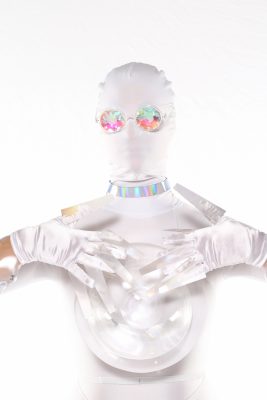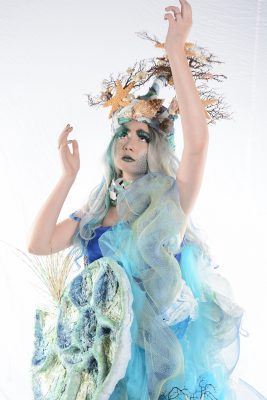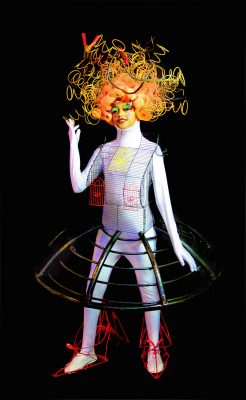The first settlers of Sandy Spring were Quakers, and their influence is still felt. So, it’s fitting that an exhibit at the Sandy Spring Museum (SSM) is named for the Quaker concept of “Inner Light.” It means everyone has a light inside and the capacity for good and evil.
The exhibit consists of 12 three-dimensional sculptures of the human form, also known as wearable art. They were made with non-traditional construction and materials like wood, metal, paper, fiber and plastic.

Increasingly popular, wearable art refers to individually designed pieces of handmade clothing or jewelry created as fine or expressive art. But aside from aesthetic considerations, wearable art pieces often make a personal or social statement.
The latter was the case with the “Inner Light” sculptures. They were entries in the 2017 annual competition sponsored by ManneqART, an international arts and educational nonprofit based in Howard County. “ManneqART inspires creativity, teaches problem-solving skills and rewards excellence in sculpture to the human form,” said Lee Andersen, the organization’s artistic director and a clothing designer in her own right. “Our name is a play on words, including both ‘mannequin’ and ‘manic.’”
The New Zealand native pointed out that ManneqART shares the same vision as the World of Wearable Art, an annual international competition in her native country, but the two are not affiliated.
Each year, ManneqART challenges competitors to create sculptures on the human form according to certain themes, which in 2017 were Ocean, Eco, Energy and Aviation. The organization offers $10,000 in awards annually to competition winners.

This year, the first collaboration between ManneqART and the SSM, participating artists were charged to include an “inner light” component in their sculptures in honor of Sandy Spring’s Quaker heritage. “The sculptures represent the duality of good and bad, positive and negative,” said Allison Weiss, SSM’s executive director. “Some literally light up.”
The life-sized sculptures include the winner of the Inner Light Award, “Glacius Angelies” by Lynne Spector (model) and Maddy Halbach of Glenwood, Maryland. A high school teacher by day who seeks creative outlets “on the side,” Halbach said her inspiration was a poster of an iceberg and a swimmer that said “freedom.” When she considered what sculpture to make for ManneqART, she remembered the poster as well as a historical event people often reference when thinking of icebergs: the disastrous sinking of the RMS Titanic after the ship hit an iceberg. “When the wings of the sculpture collapse, the entire outfit becomes one big iceberg,” Halbach explained. “Then, when the wing’s open, she becomes an ice angel.”
The under-layer of the skirt is made of fabric, with sprayed rubber and a painting process to add texture. The artist heated and bubbled plastic, then made it into the top layer of the skirt. The peplum—a short section attached to the waistline of a blouse, jacket or dress—and wings were fashioned of craft foam. The bodice is also foam, embossed with broken Christmas ornaments.

Light and dark blend in the all-blue sculpture. “The people under the angel’s wings, made with a 3-D printer, are falling,” said Halbach. “They represent the people who fell into the icy waters of the Atlantic from the Titanic.” But the angel’s wings open to welcome the souls of the dead to Heaven.
Creativity in construction and materials is matched by a clever sculpture title in Doreen Reynolds’ “Agony and the Ecxta-Sea,” a reference to “The Agony and the Ecstasy,” a novel (and film) about Michelangelo. “Ocean was my first inspiration, but as I put ideas together, I soon realized there is a huge crossover into Eco,” said Reynolds, a cosmetologist who has long been concerned with color, textures and styles. “The Eco portion of the sculpture is the most thought provoking, but the Ocean portion exemplifies the beauty of the sea and its wonders.”
Reynolds began her sculpture with a single-shouldered, royal-blue evening gown to represent the ocean’s depths. The piece’s front is indeed beautiful, with mock starfish and shells and gauzy material. But look behind it, and the ecological message is clear–and disturbing. There are bottles, cans and the plastic ties from soda cans, and words like “Kill” and “End.”
Some sculptures are illusions. Looking from afar at “Flowering Success,” created and modeled by recent high-school graduate Amanda O’Shaugnessy, the viewer sees what appears to be an elegant white gown. It’s constructed entirely of paper–specifically, the numerous college acceptance letters received by the stellar student.

“Reborn through the Flames” is the work of Katie Gramme (model Sarah Benton), a graduate of the Manhattan School of Design and costume designer. It conveys the ambivalence of human beings toward suffering. The flames represent trials that burn us to the core, and yet, allow us to be reborn to new and stronger people.
In Robert Reed’s “I Know Why the Caged Bird Lip Syncs,” a riff on the title of poet Maya Angelou’s memoir, foams and wires come out of a person’s head encased in a metal cage. The sculpture expresses the realization that those who think outside the box are forced into choosing identities and roles to fit into society.
Sandy Spring Museum considers itself “community-driven,” said Weiss. “It used to be a very traditional history museum, but now we look at history through the cultural arts.”
“Inner Light” will continue through Nov.18 at the Sandy Spring Museum, 17901 Bentley Road, Sandy Spring. Call 301-774-0022 or visit www.sandyspringmuseum.org. View this exhibit on CultureSpotMC here.